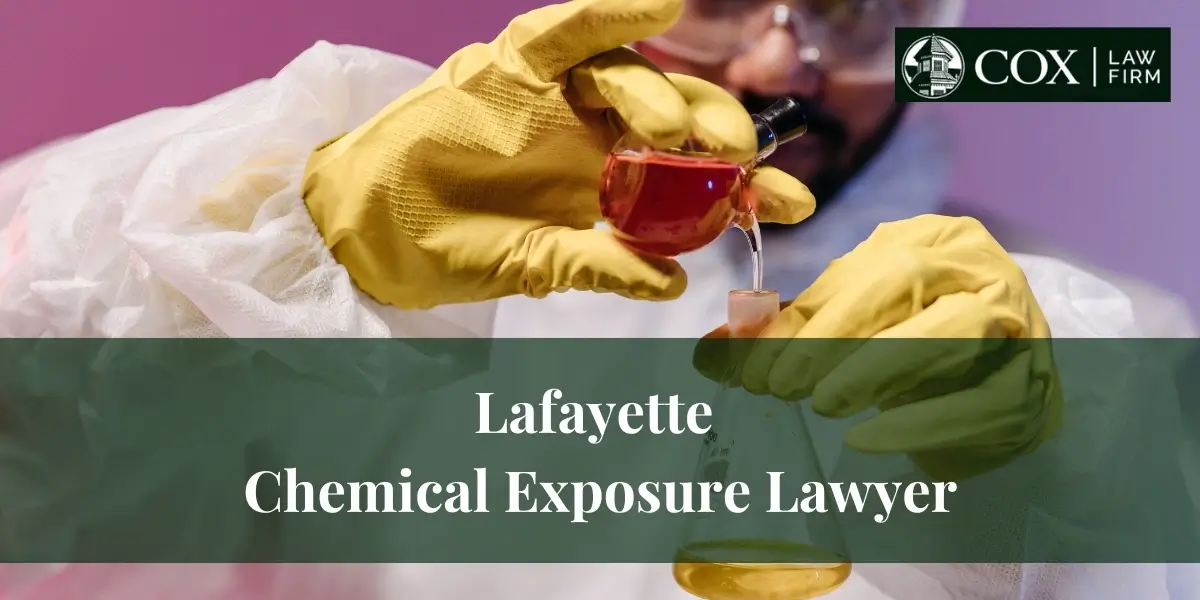Lafayette Chemical Exposure Lawyer
Lafayette Chemical Exposure Attorney
Chemical exposure injuries or illnesses can refer to those resulting from hazardous substances, like chemical burns, but they can also refer to the long-term consequences of exposure over a long period of time. When chemical exposure causes developmental illnesses like respiratory diseases and cancers, it can be more difficult to determine the cause of the illness. A Lafayette chemical exposure lawyer can help you if your illness or injury was caused by chemical exposure.

Navigating a Toxic Tort Chemical Exposure Case With the Cox Law Firm
If someone’s negligence caused you to be exposed to hazardous substances, or you were exposed while working, you may have grounds to pursue compensation. At the Cox Law Firm, we want to help you get the financial recovery you need, hold the responsible party accountable, and prevent further toxic exposure to others. Our team believes in steadfast support of those injured by the carelessness of others.
A successful claim can recover the costs of your medical expenses and some of your lost wages. When you navigate your claim with experienced legal support, you are much more likely to have a successful outcome. At the Cox Law Firm, our attorneys have 135 collective years of legal experience. Our compassionate legal team wants to help you move forward with your life.
How Does Chemical Exposure Happen?
In Lafayette, a city with a population of 121,452, chemical exposures can occur in workplaces or even in recreational areas. If you require medical assistance in Louisiana after a potential chemical exposure, Ochsner Lafayette General Medical Center (OLGMC) is located at 1214 Coolidge St in Lafayette. Our Lady of Lourdes Regional Medical Center is located at 4801 Ambassador Caffery Pkwy in Lafayette.
There are many unique ways that chemical exposure happens. The most common way that it occurs is through the inhalation or ingestion of the substance or because of contact with it. There are many places where employees and communities are exposed to hazardous chemicals, including:
- Workplaces. Many worksites may have toxic substances and chemicals stored and used in daily work. Certain industries are more likely to be hazardous, like construction, maritime, manufacturing, mining, and refining. More than 50,000 employee deaths and 190,000 illnesses are attributed to chemical exposure each year.
- Homes. Homeowners and renters can be exposed to dangerous substances in paints, cleaning supplies, pesticides, and other commonly used household items. There may also be dangerous substances used in the building of the home, such as asbestos, lead paint, or radon. Toxic mold can also grow in homes.
- Schools. Like other buildings, schools can have hazards in the form of lead paint, asbestos, or other dangerous substances and chemicals.
- Environmental contamination. Pollution can impact the environment and whole communities. This can include water or air contamination by factories, refineries, and waste sites.
The method of chemical exposure can significantly impact the investigation of your case and what you must prove in order to file a claim. If you were injured at work, you may need to prove that the exposure occurred at work. If you were exposed to dangerous materials in a home or school, you may need to show that the property owner or previous owner was negligent in addressing or warning you of these hazards.
When you work with an attorney who understands toxic tort cases, they have experience navigating and investigating many types of chemical and hazardous exposure cases and can determine what options you have for financial recovery.
What Are Common Types of Toxic Tort Cases?
Toxic tort cases may be individual personal injury claims, or they may be class action or mass tort claims. In a class action case, one person files the claim on behalf of many people harmed in a similar manner by the same party. Mass tort cases occur when many injured individuals file their cases at the same time. An attorney can help you look over your options for a claim and determine what would be most beneficial to you.
There are many types of toxic tort cases, including:
- Prescription drugs with inadequate safety warnings about side effects.
- Asbestos exposure, especially in demolition work, leads to respiratory diseases, asbestosis, and mesothelioma. In the U.S., doctors reported 2,803 new mesothelioma cases in 2021.
- Food products sold with E. coli or other bacteria.
- Cancers and other illnesses caused by pesticides used while working or at home.
FAQs
What Is Necessary to Prove a Chemical Exposure Occurred?
Proving chemical exposure occurred will require evidence such as expert witnesses, testimony from others at the scene, and medical documentation. If you are proving someone was negligent in your claim, you must prove:
- The party, such as a property owner or product manufacturer, owed you a duty of care.
- They breached their duty of care.
- This breach caused your exposure to the chemical.
- Because of the chemical exposure, you suffered an injury, developed an illness, or other damages.
What Is the Chemical Reporting Rule?
The chemical reporting rule is how manufacturers and importers of chemicals must report the chemicals they use and produce in commerce to the Environmental Protection Agency (EPA) under the Toxic Substances Control Act (TSCA). Whether a company needs to report its materials depends on the type of substance, the production volume of the substance, and the size of the manufacturer.
How Do I Sue for Chemical Exposure?
How you should file a claim for chemical exposure depends on the cause of the exposure and other factors. If you were injured while at work, you may be unable to file a civil claim but can recover compensation through the workers’ compensation system. There are rare cases in which employees, such as certain maritime workers, can file personal injury claims. If the exposure happened and you were not working, you have to prove that someone was negligent.
How Much Compensation Can You Get in a Chemical Exposure Case?
The amount of compensation you can get in a chemical exposure case depends on factors like the severity of the injuries or illness, the cost of medical treatment, and the method of financial recovery. If you are filing a workers’ compensation claim, you can recover medical expenses and partial wages. A personal injury claims additional damages, including full wages and noneconomic damages. There may be other limits, like the insurance coverage policy limits.
Contact the Cox Law Firm in Lafayette
It can be costly and incredibly upsetting to deal with developmental illnesses and other long-term consequences of chemical exposure. You are more likely to recover maximum compensation when you work with an experienced attorney. If you believe you have suffered chemical exposure at work or elsewhere, contact the Cox Law Firm to see how we can help.
Request Your
Free Consultation
Fields Marked With An “ * ” Are Required

